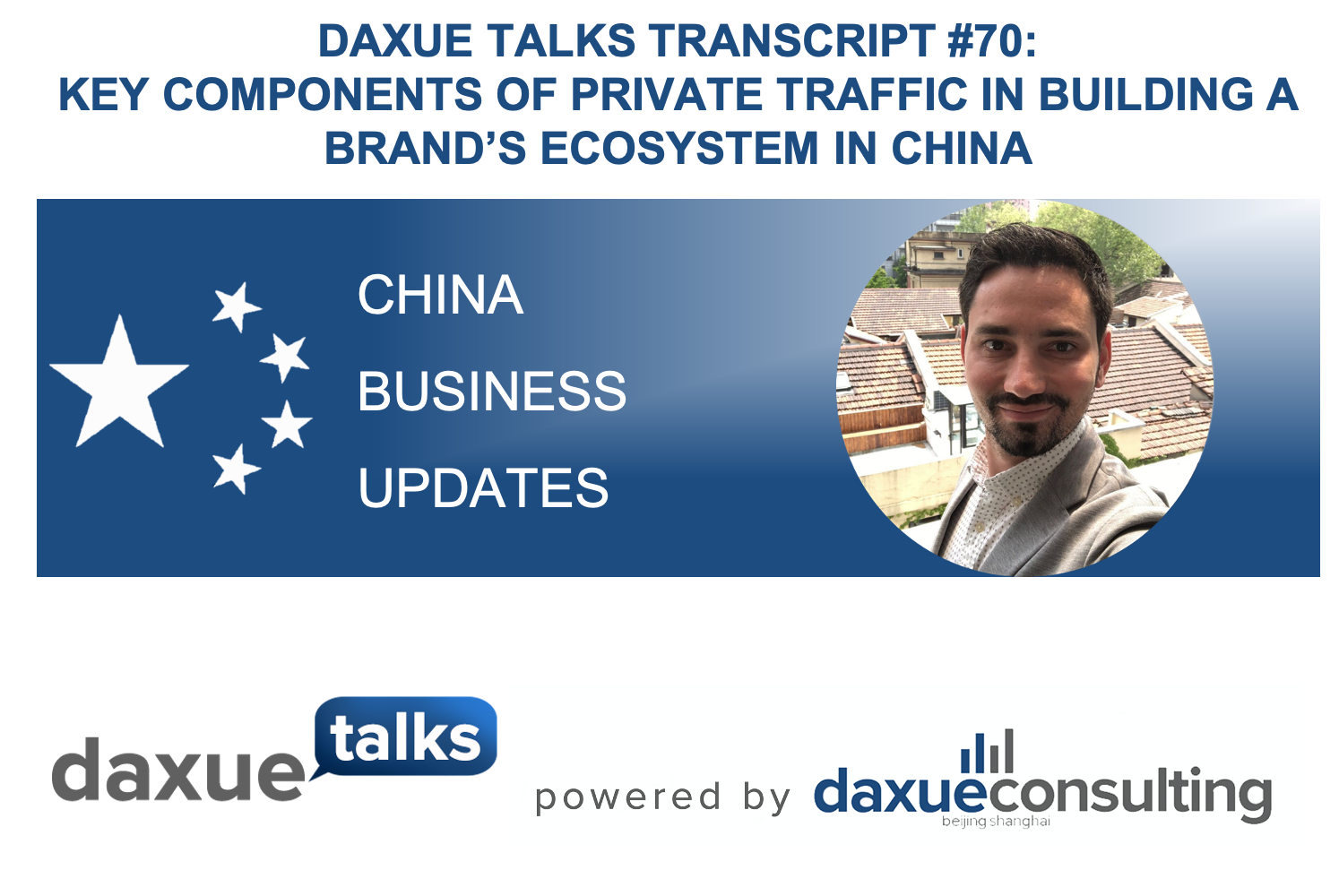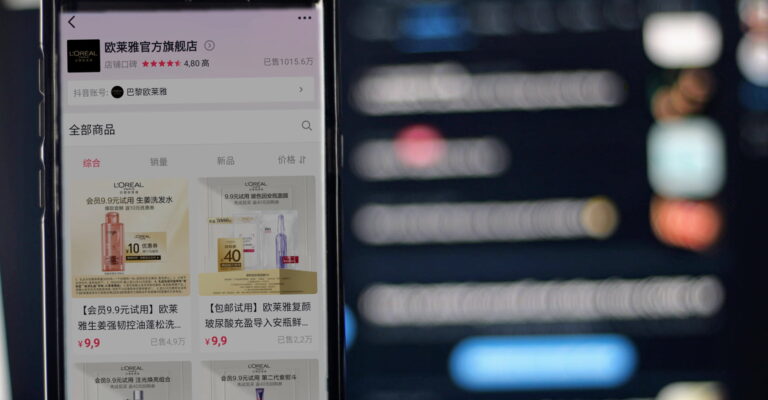Find here Daxue Talks episode 70. In this interview, Aurelien Rigart shares his expertise on the coding of mini-programs in China and tells us more about the key components of private traffic in China.
Full transcript below:
Hello everyone, I’m Aurelien Rigart I’m the co-founder and Vice President of IT Consultis, I’m from France. I’ve been in China and started this adventure nine years ago. So, IT Consultis is a digital transformation company. It’s a team of 80 people in three countries, which are China, Singapore, and Vietnam. So, we’re helping Fortune 500 and fast scaling start-ups to work on their digital transformation. It can range from eCommerce, from building mini-programs, from building websites, App, integrating systems together, or overall work as a consultant on their digital transformation initiatives.
What are the different components of private traffic? What is used to create private traffic in China besides your own website and WeChat?
So, I would say that the Chinese ecosystem is very particular. As we know it’s very different than all the other ecosystems. We have a market dominance here from Alibaba that is having about 90% of the market share when it comes to eCommerce and we also have Baidu that is way less used than Google is used in the rest of the world. So overall – brands nowadays they’re trying to create their own ecosystem which is going to be outside Alibaba because they’re really struggling to get enough data. So, private traffic here we’re talking about like the entire WeChat ecosystem, so we’re talking about the subscription account, we’re talking about the official account, but as well we’re talking about the H5 – the mini sign that can be displayed inside or the mini program.
So those are the things that we’re talking about, when we’re talking about private traffic, because when we’re talking about Red, Xiaohongshu or even like sometimes Douyin, they’re not really considered as private traffic because those software’s, those apps, they do not necessarily have an API that can be leveraged in order to afterward get the data and get the analytics to do what you want as a marketer, to do marketing automation and to aggregate this interest – so this is like really the beginning but those are – WeChat has been the core of the private traffic, and of course we have everything that is like SMS – we have as well – like, there’s a real burr now between the physical and of course the digital. So, a thing like retail and the physical store is like a magic aspect of that private traffic, and like digitalizing those stores is what enabled brands to really connect.
What frameworks exist to develop mini-programs and WeChat? Is there something like WordPress for mini-programs? Are there some building blocks that you can assemble or do you have to code from scratch?
So, it’s like there’s WordPress of course, so the way mini-programs work, it’s like built-in heedlessly. That means that there’s a mini-program, so there’s a backend and then there is a front end and both of them are connected through API’s and of course in China, you get the – the Shopify of China, that are going to be the companies that are publicly listed that are making a huge amount of revenue and having new shops open every day, every week and they have like a subscription model so it’s kind of like semi-private traffic where they keep the ownership of the data for good parts and it’s kind of like in-between where on weeks you have the opportunity to choose specific templates and kind of like plug and play them – they’re coming with a lot of functionalities but it depends where you stand as a brand.
So, if you’re a brand like Swatch or Decathlon or Porsche, you want to have your own ecosystem, you want your own infrastructure to be hosted in your own cloud, whereas here everything is going to be hosted in a cloud that belongs to basically everybody, where your data protection and your data ownership is going to be a little bit different where you cannot fully customize your user journey.
So of course, those solutions – like the SaaS solution, pre-existing kind of like plug and play – they exist but they don’t allow the full flexibility. So, coming back to your question – WordPress does exist in China and if you use it in a proper way you can have your website as a front end and a mini-program as a second front end that can be a mini-program for both, for instance, WeChat but as well as for Alipay and maybe in the future for Weibo or Douyin other platforms, because all the other platforms are launching their own mini program.
How do you drive traffic to your own channels like WeChat, websites, shops, or how do you get a phone number to create a direct connection with consumers through SMS?
Well, that’s something that is highly complicated, and what we tell all the clients is that – first of all, have a look at your asset. What are the assets that you have in hand? Are they like your retail? Your TMall presence? Is there like notoriety that you have globally that you can leverage? If you’re a brand that is abroad and wants to come to China, how you can leverage the Chinese tourists – not many at the moment but in the future when things are reopening, how you can leverage the inbound tourists to start engaging whenever they are in the US or in Europe and start having specific interactions by scanning your QR code, becoming a follower of the service account, interacting with the mini pogrom and then onboarding them through can be like a loyalty program or referral program and continue to understand where they were, how they got in touch with you at the first step and how you can build a very strong user journey to continue with targeting them when they’re in China. And if you do this well then that means you can leverage already that part and really step by step creating a quality database and building marketing automation.
So, you can build your revenue really step by step if you’re using good practices. But only if you’re using good practices. So, this is for the case of brand that is like performing the WeChat marketing and marketing automation in a proper way, leveraging their retail traffic, whether it’s outside of China.
So that could be one of them. Something that has been of course very hot – influencer, KOL, KOC – a lot of people are talking about this, so KOL – KOC there is like an entire industry whether it’s on TMall or JD and now that has been made ever stronger using the live stream function on WeChat and on the mini program where we see brands that are now directly hiring influencers through some platforms. For example like we’re talking about Park Lu which is a start-up that really helps brands or agencies selecting their KOL and so that’s something that we have seen more and more, so driving the traffic first time here in order to afterwards have repeated behaviour, of course the old fashioned way – like ensuring that basically you’re pay advertisement on your WeChat, then you’re going to have a conversion and then of course step by step you’re going to create content of interest to generate views or to generate purchases. So, this is as well possible. Of course, all the systems are isolated but if done properly you need to leverage each of the touch points and each of the asset that you have in order to drive conversion.
So, no magic bond, here again, its step by step and its very strong work that is required to not only drive traffic – because driving traffic is easy but the most important is driving traffic that’s going to bring a return on investment and that’s really the challenge here. How you’re going to build the technology stack, how you’re going to build your marketing automation and how you’re going to hire the KOL that you’re going to have the right deal that is going to enable you to generate like revenue that is basically going to favor your bottom-line? Like your top line and your bottom line together and I think a lot of brands they have been working on their top line, but they have been relying on struggling with their bottom-line. So, especially now they have to manage very specific inventory, you know like with the season-ending, they have to heavily discount in order to move to the next season when you’re talking about fashion or even specific products. So, now I think it is the challenge for brands to survive and it’s been the case in China for a long time where the top line has been more important than the bottom line but at some point – in this economy, we need to focus as well on the bottom line.
Any questions? We will find an expert to answer them. Drop your questions in the comments or send us an email – dx@daxueconsulting.com.





